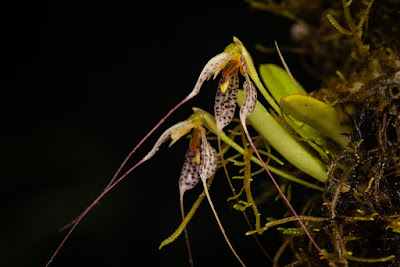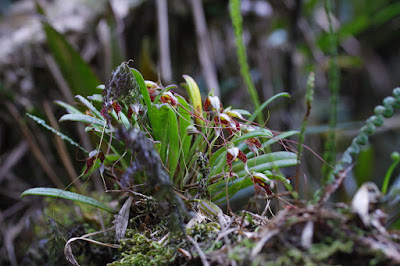Masdevallia picturata is found in wet cloud forests on riverbanks at elevations of 1500 to 2750 meters of Costa Rica, Panama, Colombia, Ecuador, Guyana, Peru, Bolivia and Venezuela. It was first collected from Venezuela somewhere near Caracas (elevation 2000 m) by Herman Wagener in 1850, but Reichenbach did not name it until 1878.
Masdevallia picturata also called as The Striking Masdevallia, Fissia picturata, Masdevallia cryptocopis, Masdevallia meleagris, Masdevallia ocanensis, Masdevallia picturata var. minor, Masdevallia picturata subsp. minor, Rodrigoa cryptocopis, is a species of the genus Masdevallia. This species was described by Heinrich Gustav Reichenbach in 1878. The epithet for this species comes from the Latin picturatus, which means painted, and refers to the intricate spots on its flowers.
IDENTIFY MASDEVALLIA PICTURATA ORCHID PLANT
Masdevallia picturata is found in wet cloud forests on riverbanks at elevations of 1500 to 2750 meters of Costa Rica, Panama, Colombia, Ecuador, Guyana, Peru, Bolivia and Venezuela. It was first collected from Venezuela somewhere near Caracas (elevation 2000 m) by Herman Wagener in 1850, but Reichenbach did not name it until 1878.
It is a mini-miniature sized, cool to cold growing epiphyte with short stems enveloped basally by tubular sheaths with a single linear to obovate leaf with a canaliculate petiole at the base.
The Striking Masdevallia blooms in the fall and winter, early spring on an erect, 4 cm long, single flowered inflorescence that is holds the flowers above the leaves. This little species is greatly variable in size, and due to the wide variations, the species was also known earlier as Masdevallia cryptocopis, Masdevallia meleagris and Masdevallia ocanensis, but these were reduced to synonyms by Luer. Plants from Central America and from Andean regions lower than 2700 m tend to be smaller and weaker and have been grouped as the subspecies minor. Those found growing in the cold cloud forests at elevations higher than 2700 m are more robust and have larger and more colorful flowers. The white sepals have purple spots, and the lateral sepals are bright orange at the base. The sepaline tails are quite long and hair-like, giving the flower a wispy appearance.
MASDEVALLIA PICTURATA ORCHID PLANT CARE AND CULTURE
Cultural information should only be used as a guide, and should be to be adapted to suit you. Your physical location; where you grow your plants, how much time you have to devote to their care, and many other factors, will need to be taken into account. Only then can you decide on the cultural methods that best suit you and your plants.
Light:
Masdevallia picturata like good light, but not direct light. 17000 - 22000 lux is a good amount of light. About 70-90% shade is recommended in summer and 25% shade to full sun in winter. It will flower better if receive plenty of light and leaves are pale green rather than dark green when in heavy shade.
Temperature:
The Striking Masdevallia like cool to intermediate growing conditions from 10°C to 23°C, whereas Masdevallia picturata ssp. minor prefers to be grown intermediate (13°C at nights, maximum 23°C at days). Ideally in winter they like a minimum of 10°C in and a maximum of 13°C. In summer the optimum range is 13 to 20°C. The temperature should not exceed 25°C and temperatures consistently above 30°C will weaken the plants and they may drop their leaves. Ensure 6-12°C day/night difference to aid flower formation.
Humidity:
This orchid prefer high humidity in summer near 75-80% and may need a humidifier over summer. Keep air circulation at all times to prevent water staying on leaves as this will encourage leaf spot.
Substrate, growing media and repotting:
Masdevallia picturata can be grown in basket or net pots. They can also be grown in pots or mounted. They prefer a continuously damp medium. Some growers use chopped sphagnum moss mixed with polystyrene chips. Others use a pine bark, polystyrene and coarse perlite mix. A mix of 5 parts bark, 5 parts perlite and 1 part fibrous, not fine, peat moss is recommended. Their roots are small and many and will fill pots very quickly when growing well. Deeper pots are generally used and plants are potted out from being divided into 5cm tubes, 7-10cm pots or 12-15cm pots depending on size.
Repot or divide the plants during the autumn or spring every two years or when they are sufficiently large enough. It is best, as with most plants, to repot when the plants are about to root to minimize disturbance. Huge clumps must be divided as a considerable number of species tend to completely rot from the oldest parts of the clump. Do not bury the base of the plants. Double potting is beneficial to keep the plant roots cool.
Watering:
The Striking Masdevallia will not tolerate dry conditions and should be kept moist but not soggy. Their roots must be able to dry out slightly between waterings. In hot weather they need daily watering but in spring and autumn weekly watering should suffice. Water in the morning so leaves can be dry by midday. The plants should be provided with rain water or distilled water or a very pure water source. It is preferable to provide a humid environment than keeping roots too wet as they are prone to rotting.
Fertilizer:
Masdevallia picturata are generally active throughout the year although growth may be slower in winter. Use a balanced fertiliser at 1/4 strength throughout the year; feed at every third or fourth watering. If in doubt do not feed. These plants do not like salt so roots will easily turn brown if over fed. If plants need a boost then a dilute foliar feed can be applied. Higher feeding schedules can be used if the grower masters their culture perfectly well. Do not use lime or dolomite lime.















COMMENTS